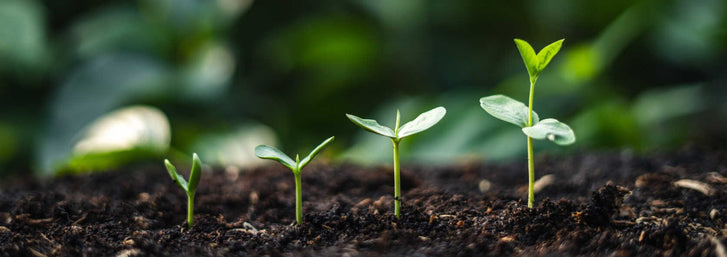
Jordan Freytag

Growing and Juicing Wheatgrass
If you’re not familiar with growing and juicing wheatgrass, I’m sure you’ve at least heard about the practice. It may seem strange to some folks at first to be juicing and drinking trays of grass grown in a small amount of soil or on a growth medium. But once folks discover the nutritional benefits and feel the difference within themselves after trying it, it doesn’t seem so strange at all.
Wheatgrass juice is known for being a powerhouse of nutrients that promotes healing and a general sense of well-being. Immediately after juicing, the juice is alive with minerals, containing concentrated amounts of Vitamins A, C, and E, iron, calcium, magnesium, and chlorophyll. Wheatgrass juice also promotes the production of hemoglobin, the chemical in red blood cells that carries oxygen through our veins and arteries. After beginning a wheatgrass regime, friends of mine are usually surprised, noticing the lift in their energy levels and even their moods.
Growing Wheatgrass only takes 5 to 7 days. It’s easy and fun, frankly. Especially once you’ve got wheatgrass trays on rotation, so a tray is ready to juice every day or every couple of days.
Sprouting Seeds
Alfalfa sprouts are a common ingredient in sandwiches and salads, adding just the right crunch, but did you know that sprouts can be an essential source of vitamins, enzymes and amino acids in high concentrations? And it’s not just alfalfa. Sprouting a wide range of seeds can allow you to consume your daily allowance and more of these vital nutrients in a new creative ways.
Basically a sprout is just infant version of the vegetable the seed will become, containing a high potency of nutrients so it can grow for a period of time before drawing nutrients from soil. Eating them at this stage allows us to benefit from that high concentration of nutrients.
Alfalfa contains vitamins A through F, including K. Mung Bean sprouts are a great source for fiber and protein and is a perfect topping for stir frys. Radish sprouts are spicy and contain zinc, potassium, carotene, and iron. In general, sprouts are quick and shockingly easy to grow using the jar, sprout sack, or sprout tray method. Sprouts are the ideal growing habit for someone with a busy schedule as sprouts need little maintenance.
Growing and Harvesting Microgreens
Microgreens used to be virtually unknown until about a decade ago, but they are quickly gaining popularity among foodies and health enthusiasts alike because of their bold flavors and potential for enhancing dishes—as well as their high nutritional content. If sprouts are considered the infants of their vegetable forms then microgreens are the adolescents. Microgreens are sprouts just about a week and half to 2 weeks older, grown in soil or on a growth medium. Think of microgreens as the methods of growing wheatgrass and sprouting seeds combined in one: sprouts that are allowed to grow in a tray for up to 3 weeks, allowing for the structure of the plant and the flavor in it to develop. In their final stage, they are slightly leafier than a sprout and usually more flavorful.
Some favorite microgreens of ours are any variety of Basil because of its powerful sweet and fresh flavor, any variety of Mustard because of its bold spiciness, and Green Pea shoots which carry the flavor of a whole fresh pea pod!
Black Oil Sunflower is a very popular microgreen because it is easy to grow and maintain and the results are out-of-this-world good! Sunflower produces these relatively thick stems with two succulent true leaves that burst with freshness.Leave a comment
Your email address will not be published. Required fields are marked *
0 Comments
No Comments yet! Be the first to start a conversation
Further Reading

Reviewing the Aquatree Garden: A True Leaf Market Experience
The AquaTree Garden is an innovative growing experience! This nifty appliance allows you to grow leafy greens, microgreens, herbs, large sprouts, and vegetable starts (like tomatoes) all at once! When it comes to indoor gardening, there is no question ...

Ashleigh Smith
2024-04-225 min read1
Parasitoid Wasps: A Beneficial Insect in the Garden
Written By Lara Wadsworth There are estimated to be around one million different species of parasitic wasps worldwide. In fact, most wasps are parasitic, which means they live on or in a host at the host's expense. For common garden pests like aphids, ...

Ashleigh Smith
2024-04-226 min read0
Succession Planting: The Key to a Continual Harvest
Do you find yourself harvesting large amounts of any given vegetable from your garden all at once? There is a solution! The practice of succession planting, or planting in segments over a period of time, allows you to harvest root vegetables, leafy gre...

Ashleigh Smith
2024-04-223 min read2
10 Natives of the Southwest USA for Pest Control
Written By Lara Wadsworth The Southwestern United States is a region incredibly unique to the rest of the country. The hot, dry weather can be challenging for plants and animals to thrive without additional help. That is why gardening with natives can ...

Ashleigh Smith
2024-04-157 min read0



